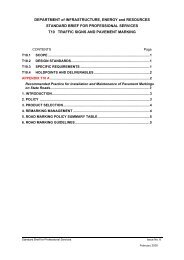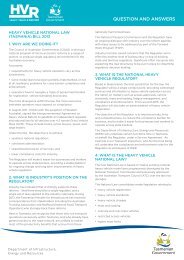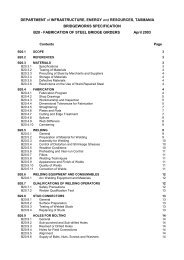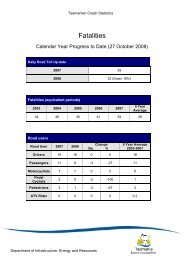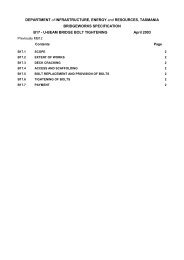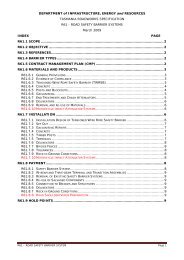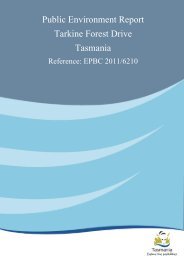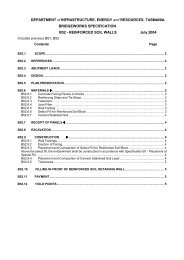Pavement and Shoulder Maintenance - Transport
Pavement and Shoulder Maintenance - Transport
Pavement and Shoulder Maintenance - Transport
You also want an ePaper? Increase the reach of your titles
YUMPU automatically turns print PDFs into web optimized ePapers that Google loves.
DEPARTMENT of INFRASTRUCTURE, ENERGY <strong>and</strong> RESOURCESTASMANIAROADWORKS SPECIFICATIONR43 – <strong>Pavement</strong> <strong>and</strong> <strong>Shoulder</strong> <strong>Maintenance</strong>November 2010IndexPageR43.1 SCOPE ...................................................................................................... 2R43.2 REFERENCES ............................................................................................. 2R43.3 DEFINITIONS ............................................................................................. 2R43.4 REQUIREMENTS ......................................................................................... 3R43.4.1Grading, Resheeting <strong>and</strong> <strong>Maintenance</strong> of Unsealed <strong>Shoulder</strong>s, Verges<strong>and</strong> Roadside Amenities .......................................................................... 3R43.4.2 Grading, Resheeting <strong>and</strong> the Repair of <strong>Pavement</strong> Defects on UnsealedRoads ................................................................................................... 4R43.4.3 Reconstruction Patches ........................................................................... 4R43.4.4 Potholes in Unsealed Surfaces .................................................................. 5R43.4.5 Disposal of Material ................................................................................ 5R43.5 PERFORMANCE CRITERIA ............................................................................ 5R43.4.1 <strong>Maintenance</strong> in Construction Contracts ...................................................... 5R43.4.2 Network <strong>Maintenance</strong> Contracts ................................................................ 7R43.5 MEASUREMENT AND PAYMENT ..................................................................... 9R43.5.1 <strong>Maintenance</strong> in Construction Contracts ...................................................... 9R43.5.2 Network <strong>Maintenance</strong> Contracts ................................................................ 9R43 <strong>Pavement</strong> <strong>and</strong> <strong>Shoulder</strong> <strong>Maintenance</strong> Page 1
R43.1 SCOPEDEPARTMENT of INFRASTRUCTURE, ENERGY <strong>and</strong> RESOURCESTASMANIAROADWORKS SPECIFICATIONR43 – <strong>Pavement</strong> <strong>and</strong> <strong>Shoulder</strong> <strong>Maintenance</strong>November 2010This Specification sets out the maintenance requirements for:a) Sealed road pavements - grading <strong>and</strong> resheeting of unsealed shoulders, verges <strong>and</strong>roadside amenities to manage:• <strong>Shoulder</strong> wear <strong>and</strong> edge drop-off• Corrugations, scouring <strong>and</strong> channels• Potholes• Loose materialb) Unsealed road pavements - grading <strong>and</strong> resheeting of unsealed road pavements <strong>and</strong>roadside amenities to manage:• Corrugations, scouring, rutting, minor potholing• Potholes• Loose material• Deformations, including shovingc) Reconstruction patches in sealed <strong>and</strong> unsealed pavements to manage localisedpavement defects.d) Pothole Repairs on unsealed surfaces.R43.2 REFERENCESThis Specification shall be read in conjunction with the following specifications• G1 – General Provisions/MG1 <strong>Maintenance</strong> General Provisions• G2 - Contract Management Plan/MG2 <strong>Maintenance</strong> Contract Management Plan• G3 - Traffic Management• G4 – Compaction Assessment• R24 – Geotextiles• R33 – Subsoil Drains• R40 – <strong>Pavement</strong> Base <strong>and</strong> Subbase• R59 – Sealed <strong>Pavement</strong> <strong>Maintenance</strong>R43.3 DEFINITIONSTable R43.1 DefinitionsNAMEChannelCoarseTextureCorrugationsDeformationDrainage GripEdge Drop OffDESCRIPTIONSteep, irregularly sided, relatively linear feature, commonly found in thedirection of maximum slope or along a wheelpath.Protrusion of very coarse aggregate or rock (particle size usually greaterthan 75 mm) from the pavement surface, some loose on surface.Transverse undulation closely <strong>and</strong> regularly spaced with wavelengthstypically in the range of 0.3m – 2.0mA depression or bulge in the road surface, outside of the constructed(intended) profile.A channel to disperse water from the road <strong>and</strong> table drain that assistswith the prevention of scouring of shoulders by reducing longitudinalflow lengths.The vertical distance from the surface of the seal at the edge to thesurface of the shoulder.R43 <strong>Pavement</strong> <strong>and</strong> <strong>Shoulder</strong> <strong>Maintenance</strong> Page 2
NAMEFalse DrainsLooseMaterialsPotholeReconstructionPatchesRuttingShovingUnsealed<strong>Shoulder</strong>sDEPARTMENT of INFRASTRUCTURE, ENERGY <strong>and</strong> RESOURCESTASMANIAROADWORKS SPECIFICATIONR43 – <strong>Pavement</strong> <strong>and</strong> <strong>Shoulder</strong> <strong>Maintenance</strong>November 2010DESCRIPTIONShallow drains created at the back of the shoulder or verge duringmaintenance operations that restrict the flow of water to the true drainstructure.Unbound fine or coarse gravel materials on the pavement surface. Canoccur as a variable thickness layer (sheet) over the whole surface, or innarrow continuous mounds between wheelpaths or lanes, or betweenthe outer wheel path <strong>and</strong> table drains.A bowl shaped depression in the pavement. Potholes can have steep orgently sloping sides <strong>and</strong> be of irregular shape.The term reconstruction patch is used where the existing pavementmaterial has been removed <strong>and</strong> the resulting excavation is to bereconstructed. The repair may be confined to the surfacing course orextend to the full depth of the pavement. Reconstruction patches willusually be straight sided. Terms such as millout <strong>and</strong> digout are alsocommonly used in reference to this form of pavement repair.Longitudinal <strong>and</strong> relatively smoothly shaped deformation at thewheelpaths. Wet weather ruts tend to be steep sided <strong>and</strong> reflect theimpression of the tyre into the road surfaces.Plastic bulging of pavement surface commonly occurring in associationwith localised pavement depressions or rutting.Are defined as the area of shoulder from the edge of the seal to theverge.R43.4 REQUIREMENTSR43.4.1 Grading, Resheeting <strong>and</strong> <strong>Maintenance</strong> of Unsealed <strong>Shoulder</strong>s, Verges <strong>and</strong>Roadside AmenitiesNew unsealed shoulder <strong>and</strong> verge material shall meet the requirements of St<strong>and</strong>ardSpecification R40 <strong>Pavement</strong> Base <strong>and</strong> Subbase unless otherwise specified.<strong>Shoulder</strong> <strong>and</strong> verge material shall not encroach onto the sealed pavement at any time exceptduring the maintenance operations. The surface shall be compacted to form a dense, tight <strong>and</strong>uniform surface free of defects or soft spots.<strong>Shoulder</strong> crossfalls shall not be increased as a result of undertaking this activity. There will alsobe no “false drains” created on the outer edge of the shoulder or verge as a result ofmaintenance grading operations.The use of drainage grips in areas where transverse water flow from sealed pavements isrestricted by materials that are higher than the sealed surface will only be accepted as atemporary solution. All offending materials shall be removed within the required responsetimes. The shape of shoulders at road junctions <strong>and</strong> access points to adjoining properties shallbe maintained.Excess material shall not be windrowed into any adjacent vegetation.Grading shall include the removal of grassed areas for the full shoulder width, generally to theguidepost line, together with the maintenance of drainage grips to aid in the flow of water fromthe pavement. The invert level in table drains shall provide adequate drainage from thepavement directly after grading.Culvert inlets <strong>and</strong> outlets shall be cleared of windrowed material.R43 <strong>Pavement</strong> <strong>and</strong> <strong>Shoulder</strong> <strong>Maintenance</strong> Page 3
DEPARTMENT of INFRASTRUCTURE, ENERGY <strong>and</strong> RESOURCESTASMANIAROADWORKS SPECIFICATIONR43 – <strong>Pavement</strong> <strong>and</strong> <strong>Shoulder</strong> <strong>Maintenance</strong>November 2010The formation width shall not be excessively widened <strong>and</strong> adjacent vegetation shall not besubject to excessive damage.The above activities shall not contribute to the spread of pest plants or other weeds.R43.4.2 Grading, Resheeting <strong>and</strong> the Repair of <strong>Pavement</strong> Defects on Unsealed RoadsNew material shall meet the requirements of St<strong>and</strong>ard Specification R40 <strong>Pavement</strong> Base <strong>and</strong>Subbase, unless otherwise specified.Where additional pavement material is required on the road surface due to deficiencies inshape, roughness or remaining material characteristics the Contractor shall notify theSuperintendent. The Superintendent shall nominate the thickness of resheeting material if hedeems the additional material is required.The graded surface shall be compacted to ensure a dense, tight <strong>and</strong> uniform surface sufficientto prevent unravelling, rutting by traffic <strong>and</strong> excessive moisture penetration from the surface.The existing surface shall be reshaped to a profile with cross fall of between 4% <strong>and</strong> 6% withsuperelevation, or to match the existing profile.The length of road where the running surface is being disturbed by grading or other means, <strong>and</strong>which produces a windrow of loose material, shall not exceed 1 km. The height of the windrowof loose material shall not exceed 200mm.No windrows shall be left within the main carriageway overnight. Existing drainage grips are tobe reopened within 24 hours. The existing surface shall be tined or scarified to a depth of25mm prior to the placement of additional material.Where the unsealed carriageway changes to a sealed carriageway a smooth transition shall bemaintained between the two surfaces over a 20m section within the unsealed carriageway. Thesealed carriageway shall be kept free of all maintenance aggregate except during surface <strong>and</strong>shape restoration.The invert level in table drains shall provide adequate drainage from the pavement directlyafter grading.The formation width shall not be excessively widened <strong>and</strong> adjacent vegetation shall not besubject to excessive damage.R43.4.3 Reconstruction PatchesThe Contractor shall mark on the road the location <strong>and</strong> extent of the proposed patch. The areashall be approximately rectangular <strong>and</strong> shall extend into sound pavement on all sides. Whereshoving of the pavement is occurring the Contractor shall remove the bulge of material <strong>and</strong>manage the defect until authorised to undertake the reconstruction patch.The Contractor shall detail the proposed design for the patching <strong>and</strong> submit it for approval withthe monthly program. The design shall include subsoil drainage <strong>and</strong> geotextile wherenecessary. The design shall be consistent with the extent of work involved <strong>and</strong> shall provideassurance to the Superintendent that both the structural aspect <strong>and</strong> drainage component of thepatching has been considered.Where subsoil drainage <strong>and</strong> a geotextile layer have not been allowed for in the design of thepatch <strong>and</strong> during construction is subsequently deemed necessary, the Superintendent is to beadvised before the works proceed further.R43 <strong>Pavement</strong> <strong>and</strong> <strong>Shoulder</strong> <strong>Maintenance</strong> Page 4
DEPARTMENT of INFRASTRUCTURE, ENERGY <strong>and</strong> RESOURCESTASMANIAROADWORKS SPECIFICATIONR43 – <strong>Pavement</strong> <strong>and</strong> <strong>Shoulder</strong> <strong>Maintenance</strong>November 2010For sealed pavements, the surface shall be maintained in a trafficable condition with a smoothtransition to the surrounding pavement until sealed. Granular patches on sealed pavementsshall be sealed within 5 working days after opening of the pavement unless otherwise directedby the Superintendent.Edges shall be saw cut or planed, to 150mm outside the limits of the defect, both parallel <strong>and</strong>transverse to the direction of traffic. Where asphalt is being used to complete the repair, thebase <strong>and</strong> sides of the patch shall have a tack coat of bitumen emulsion (0.25 - 0.5 L/m²)applied. The finished repair shall be “blinded” with a light covering of s<strong>and</strong>.All requirements of St<strong>and</strong>ard Specification R59 Sealed <strong>Pavement</strong> <strong>Maintenance</strong> shall apply tothese repairs.The Contractor shall be responsible for reporting/rectifying any threats to the pavementstability in the proximity of the patch.Subsoil drains shall be in accordance with St<strong>and</strong>ard Specification R33 Subsoil Drains.Geotextile shall be in accordance with St<strong>and</strong>ard Specification R24 Geotextiles.Excavated pavement material shall not be left on or adjacent to the roadside or placed where itcan impede surface drainage.R43.4.4 Potholes in Unsealed SurfacesNew material shall meet the requirements of St<strong>and</strong>ard Specification R40 <strong>Pavement</strong> base <strong>and</strong>Subbase unless otherwise directed. In addition to this requirement, where practical, materialswith similar properties to the existing pavement material should be used.The repaired surface shall be compacted to ensure a dense, tight <strong>and</strong> uniform surface sufficientto prevent unravelling by traffic <strong>and</strong> excessive moisture penetration from the surface.R43.4.5 Disposal of MaterialAll material to be disposed of shall become the property of the Contractor unless otherwise statedin the Specification. The Contractor shall arrange suitable off-site disposal areas for all suchmaterial. All such material including detritus <strong>and</strong> debris shall be removed <strong>and</strong> disposed inaccordance with all relevant legislation <strong>and</strong> St<strong>and</strong>ard Specifications G1 General Provisions/MG1<strong>Maintenance</strong> General Provisions <strong>and</strong> G2 Contract Management Plan/MG2 <strong>Maintenance</strong> ContractManagement Plan.R43.5 PERFORMANCE CRITERIAR43.4.1 <strong>Maintenance</strong> in Construction ContractsThe Intervention Level <strong>and</strong> the condition following treatment are set out in Table R43.2Intervention Levels Construction Contracts.R43 <strong>Pavement</strong> <strong>and</strong> <strong>Shoulder</strong> <strong>Maintenance</strong> Page 5
ROUTINEMAINTENANCETREATMENTGrading <strong>and</strong>resheeting of<strong>Shoulder</strong>s,Verges, RoadsideAmenities,Unsealed Roads<strong>and</strong> the Repair of<strong>Pavement</strong>Defects inUnsealedSurfaces.DEPARTMENT of INFRASTRUCTURE, ENERGY <strong>and</strong> RESOURCESTASMANIAROADWORKS SPECIFICATIONR43 – <strong>Pavement</strong> <strong>and</strong> <strong>Shoulder</strong> <strong>Maintenance</strong>November 2010Table R43.2 Intervention Levels Construction ContractsINTERVENTION LEVELUnsealed <strong>Pavement</strong>sRutting, shoving, potholing,channelling or corrugations thatindividually or collectively are >30mm in depth, as measured under a1.2m straight edge, over a combinedlength of more than 250m for any1km section of road.<strong>Shoulder</strong> wear <strong>and</strong> edge dropoff >30mm depth for lengths exceeding:10% of the project length for HPCS<strong>and</strong> Class 1 roads.20% of the project length for Class 2roads.30% of the project length for Class 3roads.MINIMUM CONDITION AFTERTREATMENTThe full length of the defect shallbe reinstated to an appropriateservice level.The full length of the project shallbe reinstated to a condition suchthat no dropoff is greater than10mm.e) Defects such as channels,corrugations, rutting, shoving <strong>and</strong>soft spots shall be limited to lessthan 2% of the total area directlyafter grading.Edge of seal drop off > 50 mm forany length.<strong>Shoulder</strong> or verge rough <strong>and</strong> scouredwith rutting or corrugations of 50 mmdepth.Water ponding over lengths of 5m.<strong>Shoulder</strong> or verge material orvegetation on the shoulder or verge ishigher than edge of seal or impedesthe free flow of water to the drainagesystem.Potholes >50mm in depth <strong>and</strong> or>300mm in any orientation in theplane of the road surface.Shoving with a depth of 75mmmeasured under a 1.2m straightedge.<strong>Shoulder</strong> or verge materialencroached onto the sealed pavement> 200mm from seal edge.Localised reinstatement isacceptable to prevent thiscondition being reached howeverthe repair shall provide smoothtransitions to the existing profileat each end of the repair.Localised reinstatement isacceptable to prevent thiscondition being reached howeverthe repair shall provide smoothtransitions to the existing profileat each end of the repair.Defect repaired.All material that restricts the flowof water is removed.The repair shall be flush with thesurrounding surface.Repaired in accordance with therequirements of ReconstructionPatches.All shoulder <strong>and</strong> verge materialremoved from the sealedpavement.R43 <strong>Pavement</strong> <strong>and</strong> <strong>Shoulder</strong> <strong>Maintenance</strong> Page 6
ROUTINEMAINTENANCETREATMENT<strong>Maintenance</strong>Grading ofUnsealed<strong>Pavement</strong>sLoose Material onUnsealed RoadsReconstructionPatchesDEPARTMENT of INFRASTRUCTURE, ENERGY <strong>and</strong> RESOURCESTASMANIAROADWORKS SPECIFICATIONR43 – <strong>Pavement</strong> <strong>and</strong> <strong>Shoulder</strong> <strong>Maintenance</strong>November 2010INTERVENTION LEVELAs required by the Principal.Loose Material >100mm in depth atany location on the pavementLoose material > 50mm in depth,over an area >10m2, within thetrafficable area of the road.Loose material > 50mm depth outsideof the trafficable area over acontinuos length of 100m within any1km section of road <strong>and</strong>/or any loosematerial >50mm in depth that mayrestrict drainage.Sprayed Seal, Asphalt <strong>and</strong> Unsealed<strong>Pavement</strong>sAny individual areas of pavement ≤ 20m² with structural deficiencies.MINIMUM CONDITION AFTERTREATMENTDefects such as channels,corrugations, rutting, shoving <strong>and</strong>soft spots shall be limited to lessthan 2% of the total area directlyafter grading.All loose materials shall beremoved from the pavement atthe identified location.The repaired pavement shall havea maximum vertical deviationunder a 3 m straight edge of 10mm in any direction. Theperimeter of the repair shall beflush with the existing surface.Sealed surfaces onlyThe surfacing shall provide auniform water-resistantbituminous layer to protect thepavement layers from surfaceinfiltration of moisture.The type <strong>and</strong> quality of thesurface finish is to be textured sothat there is uniform skidresistance across the road.R43.4.2 Network <strong>Maintenance</strong> ContractsThe Intervention Level <strong>and</strong> the condition following treatment or reinstatement are set out inTable R43.3 Intervention Levels Network <strong>Maintenance</strong> Contracts.ROUTINEMAINTENANCETREATMENTRepair of<strong>Pavement</strong>Defects onUnsealed Roads.Loose Materialon UnsealedRoadsTable R43.3 Intervention Levels Network <strong>Maintenance</strong> ContractsINTERVENTION LEVELAs specified in the ContractAs specified in the ContractMINIMUM CONDITION AFTERREINSTATEMENTThe final repair shall have amaximum vertical deviation,under a 3m straight edge, of 10mm in any direction.The repair shall be flush with theexisting surface.All loose materials shall beremoved from the pavement atthe identified location.Pothole As specified in the Contract. The final repair shall have aR43 <strong>Pavement</strong> <strong>and</strong> <strong>Shoulder</strong> <strong>Maintenance</strong> Page 7
ROUTINEMAINTENANCETREATMENT<strong>Maintenance</strong> onUnsealedSurfaces.Shoving Repairon UnsealedRoads<strong>Maintenance</strong>Grading onUnsealed Roads<strong>Maintenance</strong> ofUnsealed<strong>Shoulder</strong>s,Verges <strong>and</strong>RoadsideAmenitiesEdge Dropoff<strong>Maintenance</strong>ReconstructionPatches onSealed <strong>and</strong>Unsealed<strong>Pavement</strong>s<strong>Maintenance</strong>Grading onUnsealed<strong>Shoulder</strong>sDEPARTMENT of INFRASTRUCTURE, ENERGY <strong>and</strong> RESOURCESTASMANIAROADWORKS SPECIFICATIONR43 – <strong>Pavement</strong> <strong>and</strong> <strong>Shoulder</strong> <strong>Maintenance</strong>November 2010INTERVENTION LEVELAs specified in the ContractAs specified in the ContractAs specified in the ContractAs specified in the ContractAs specified in the ContractAs specified in the ContractMINIMUM CONDITION AFTERREINSTATEMENTmaximum vertical deviation,under a 3m straight edge, of10mm in any direction.The repair shall be flush with theexisting surface.The final repair shall have amaximum vertical deviation,under a 3m straight edge, of10mm in any direction.The repair shall be flush with theexisting surface.Defects such as channels,corrugations, rutting, shoving <strong>and</strong>soft spots shall be limited to lessthan 2% of the total area directlyafter grading.Defects such as channels,corrugations, rutting, shoving <strong>and</strong>soft spots shall be limited to lessthan 2% of the total area directlyafter grading.The crossfall of the shouldersshall be reinstated to a consistentprofile.The final repair shall have amaximum vertical deviation,under a 3m straight edge, of10mm in any direction.The repair shall be flush with theexisting surface.Sealed surfaces onlyThe surfacing shall provide auniform water-resistantbituminous layer to protect thepavement layers from surfaceinfiltration of moisture.The type <strong>and</strong> quality of thesurface finish is to be textured sothat there is uniform skidresistance across the road.Defects such as channels,corrugations, rutting, shoving <strong>and</strong>soft spots shall be limited to lessthan 2% of the total area directlyafter grading.R43 <strong>Pavement</strong> <strong>and</strong> <strong>Shoulder</strong> <strong>Maintenance</strong> Page 8
DEPARTMENT of INFRASTRUCTURE, ENERGY <strong>and</strong> RESOURCESTASMANIAROADWORKS SPECIFICATIONR43 – <strong>Pavement</strong> <strong>and</strong> <strong>Shoulder</strong> <strong>Maintenance</strong>November 2010R43.5 MEASUREMENT AND PAYMENTR43.5.1 <strong>Maintenance</strong> in Construction ContractsPayment for the maintenance management of pavement <strong>and</strong> shoulders shall include:• the provision of all plant, labour, materials <strong>and</strong> disposal of waste materials• grading <strong>and</strong> resheeting of shoulders, verges, roadside amenities, unsealed roads, repairof pavements on unsealed roads.Payment shall be on pro-rata basis over the contract period (ref schedule of rates: 4.07 to4.11).R43.5.2 Network <strong>Maintenance</strong> ContractsPayment shall be in accordance with the relevant clauses <strong>and</strong> attachments in the Basis ofPayment section of the Contract <strong>and</strong> shall include the supply of all plant, labour, materials <strong>and</strong>disposal of waste materials.R43 <strong>Pavement</strong> <strong>and</strong> <strong>Shoulder</strong> <strong>Maintenance</strong> Page 9



